White bugs in the dirt: Do we have to eliminate them?
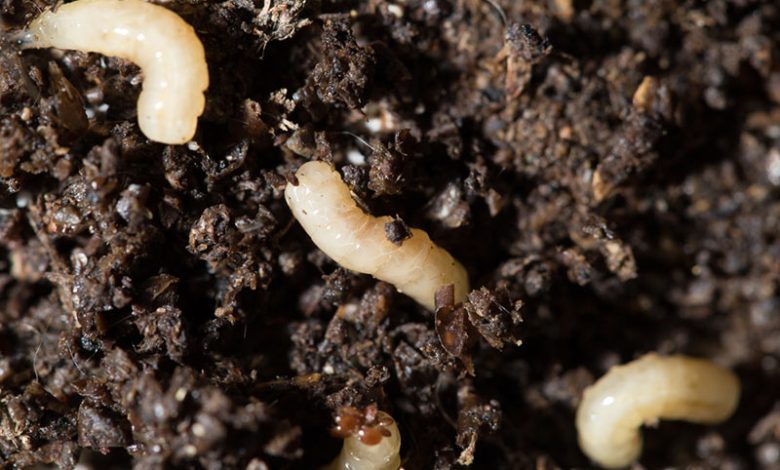
Hello to all agrohuerters. In today’s article we are going to learn how to identify the white bugs in the soil of our plants.We will also see if they are good or not and how we can eliminate the harmful white bugs.

White bugs in the soil of plants
Have you ever seen white bugs in the soil of the garden or in your pots? Do they have wings, are they so small that you cannot see them or do they look like worms?
I remind you that not all the bugs we see on our plants are harmful. There are predatory insects or parasitoids of other insects that can help us put an end to pests in the garden.
Do not worry that together we will be able to find out who they are in each case.
White bugs in potting soil: Collembola
I already anticipate that most of the times you see small white bugs on the ground it will be Collembola. Springtails are arthropods but are not considered insects. They belong to an order called « Collembola «. These little bugs are present in all parts of the world and are surely one of the most numerous animals on the planet.
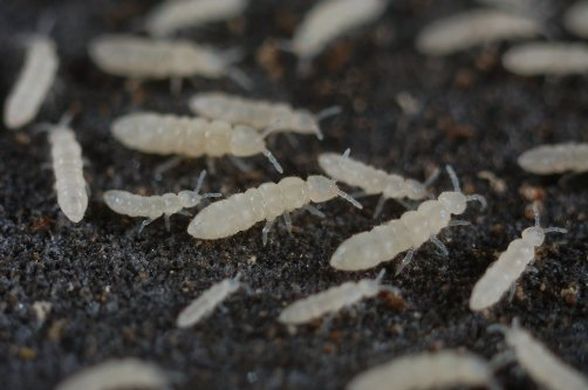
What are springtails?
Springtails can have different colors: white, black, brown, etc. However, the ones we usually find in the soil of our pots are usually white. Also, they are very small.
The funniest thing about these little white bugs on earth is that when they are attacked by a predator, they jump! Yes, they can jump up to 15 cm, it’s amazing! They do this thanks to an appendage they have on their body.
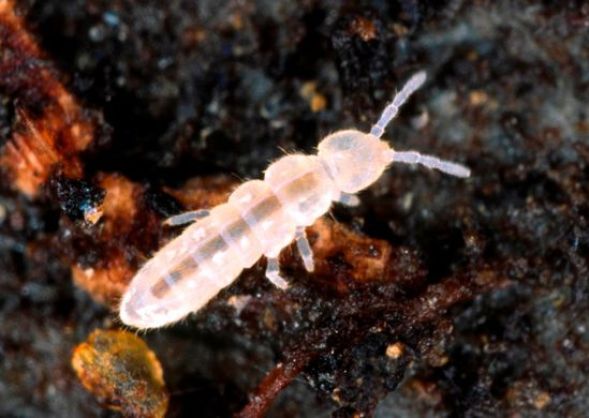
Are springtails bad?
This is one of the most common questions related to springtails. The answer is: generally NO. There are some exceptions, such as Protaphorura armata, which attacks sugar beet crops.
In most cases they can be good for our floors. They are decomposers of plant and animal debris and can attack some species of nematodes.
In addition, there are people who cultivate springtails to use them as food for small amphibians, other insects (for example mantids) or aquatic animals.
White millipede on the ground
Other white bugs on land, slightly larger than the springtails that we can find on land, may be millipedes. In this case, one in particular called Scutigerella immaculata. As you can see in the following photo, it is whitish in color and we must be careful with it since it likes to feed on the roots of our plants.
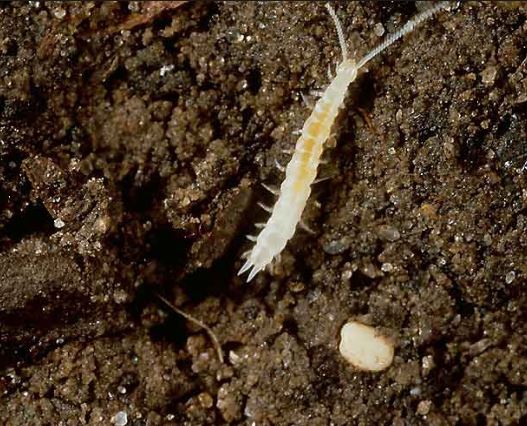
white flies on the ground
If I talk to you about white, small insects with wings … surely the “ white fly ” (Trialeurodes vaporariorum) comes to mind. Indeed, the whitefly is one of the most classic pests in any orchard or garden. But you have to be very careful and try to locate it as soon as possible!
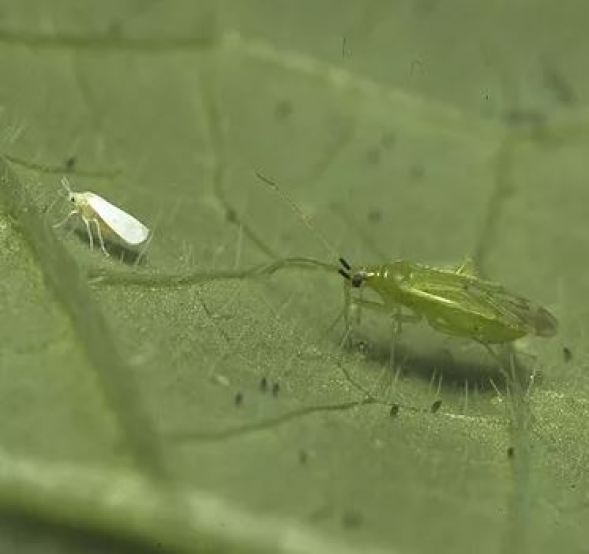
Most of the time the whitefly hides on the underside (underside) of the leaves. However, we can sometimes find whiteflies in the soil of our plants. This was the case of one of the readers who sent us a photo a week ago showing some white bugs on the ground. Indeed it was the white fly.

If you want to know how to control the white fly, consult the following link where we tell you how to do it step by step: « control the white fly in the orchard «.
Small white bugs in the dirt: Mites
Mites are present everywhere we go. Therefore, another one of the white bugs on earth to put on the list is mites.
One of the most famous mites and known under the name » bulb mite » is Rhizoglyphus robini. It can affect, as its name suggests, plants with bulbs such as onions, garlic,… and other crops such as rice, wheat, potatoes or carrots.
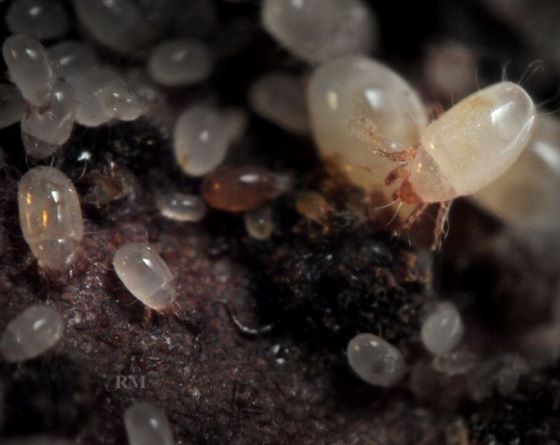
These mites are difficult to remove with chemicals alone. To control them, different strategies can be followed.
Preventive measures: if attacks are detected, carry out crop rotations, avoiding susceptible species such as onions and garlic.
Solarization of soils: This usually works in outdoor crops in warm areas.
Chemical treatments: use of acaricides.
If you want more information about mites you can consult a couple of articles that we have on:
Sanjuanero beetle larva. white worm
Other white bugs that we can find on the ground are the larvae of the sanjuanero beetle (Melolontha melolontha). They are also known as white worms.

These larvae can measure up to 40 mm and are very voracious, they love to eat the roots of herbs, such as grass and also clover.
To eliminate them, you can use a granular insecticide for soil insects such as chlorpyrifos in the form of granules. Insecticide dissolved in the irrigation water can also be added.
As an ecological treatment, biological control can be carried out, with Heterorhabditis bacteriophora, which are «good» nematodes that attack these larvae. Not to be confused with the nematodes that attack our plants.
And as a preventive measure, dig and remove the soil, as this makes laying difficult and exposes the larvae to the sun and to animals that can eat them.
Adults tend to cause less damage, but like to eat leaves from trees such as birch, plum, maple, or oak. Eliminating the adults is more difficult, so it is recommended to act against the larvae.
Other larvae and worms in the soil
Do not forget that many larvae spend the winter buried in the ground so you can also see them on the ground. And of course, many types of worms and earthworms. If you are more curious about these types of animals, I can do an article about them later, what do you think?
To finish, I leave you here another more general article about bugs that you can find in the soil of your orchards.
References
- Ministry of Agriculture, Fisheries and Food. (2018). Registration of phytosanitary products.
- Robledo, A., Van der Blom, J., Sanchez, J.A., Torres, S. (2009). Biological control in horticultural greenhouses. Phytoma. COEXPHAL and FAECA. 178.
- Conijn, CGM, Altena, K. and Lesna, I. (1997). Biological control of the bulb mite Rhizoglyphus robini by the predatory mite Hypoaspis aculeifer on lilies: implementation in practice. Acta Horticulturae 430: 619-624.
- Faria, M., Wraight, S. Biological control of Bemisia tabaci with fungi. Crop Protection. 20(9), 2001, 767-778.
This is all for today agrohuerters. I hope you liked the article about white bugs on earth. Do not hesitate to leave us comments with your doubts or experiences.

![Photo of Plague Thrips: [Detection, Steps to follow and Products to use]](https://www.complete-gardening.com/wp-content/uploads/2022/08/plague-thrips-detection-steps-to-follow-and-products-to-use-390x220.png)

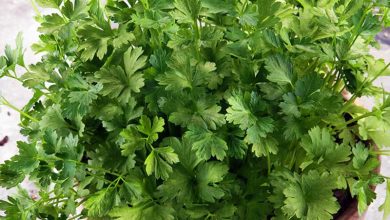
![Photo of Properties of Almonds: [A Very Powerful Food]](https://www.complete-gardening.com/wp-content/uploads/2022/08/properties-of-almonds-a-very-powerful-food-390x220.jpg)